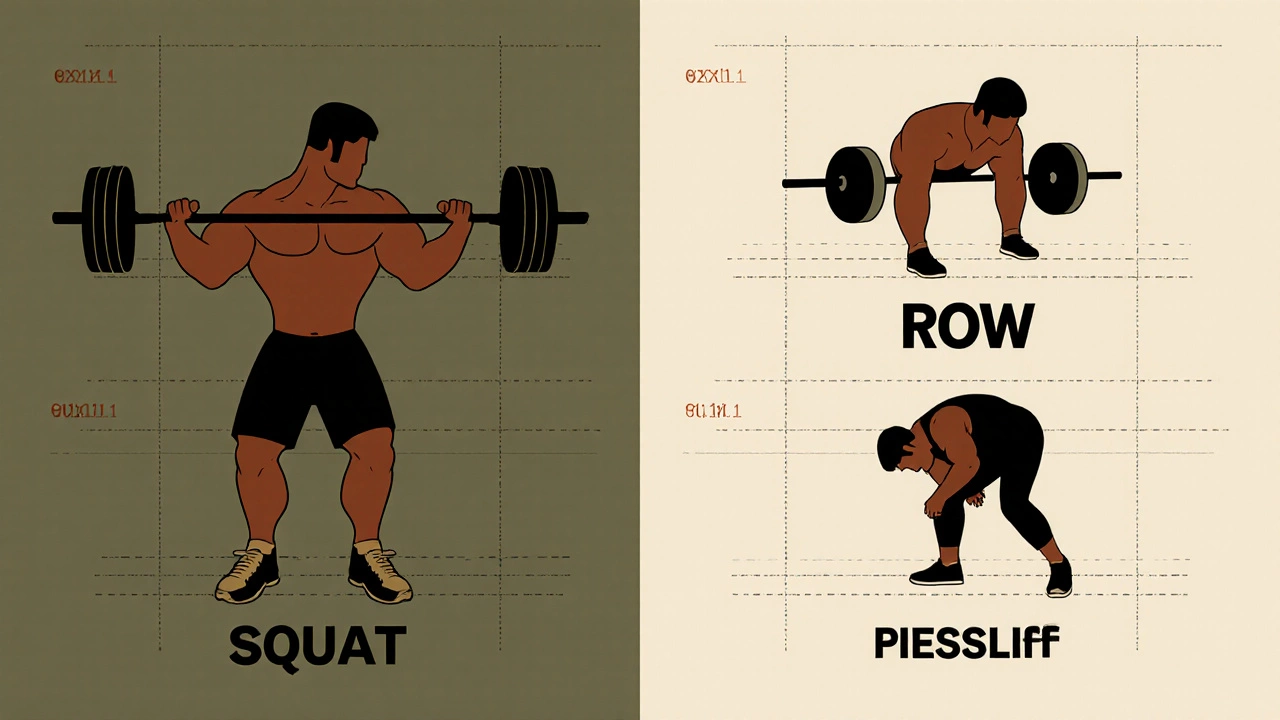What Is the 5x5 Rule in the Gym? A Simple Strength Building Method
 Oct, 28 2025
Oct, 28 2025
5x5 Strength Progression Calculator
How to Use This Calculator
Step 1: Select your primary exercise
Step 2: Enter your estimated one-rep max (or current working weight)
Step 3: Calculate your starting weight and track weekly progress
Exercise Selection
Progression Calculator
Starting Weight: kg
(60-70% of your 1RM)
Weekly Progression
| Week | Session 1 | Session 2 | Session 3 | Weekly Progress |
|---|
Want to get stronger without spending hours in the gym? The 5x5 rule is one of the oldest, simplest, and most effective strength training methods still used today. It doesn’t require fancy equipment, complex programming, or endless sets. Just five sets of five reps-done consistently-with a little discipline and smart progression.
What Exactly Is the 5x5 Rule?
The 5x5 rule means doing five sets of five repetitions for key compound lifts. That’s it. No more, no less. The lifts usually include the barbell back squat, deadlift, bench press, overhead press, and barbell row. These are movements that work multiple muscle groups at once, making them incredibly efficient.
This method was popularized in the 1950s by strength coach Bill Starr and has been used by powerlifters, military personnel, and everyday gym-goers ever since. It’s not a bodybuilding program. It’s not for endurance. It’s built for one thing: building raw, measurable strength.
Each workout focuses on these big lifts. You don’t do isolation exercises like bicep curls or leg extensions unless you’re correcting a muscle imbalance. The goal is to get stronger on the main lifts, week after week.
How the 5x5 Rule Works
The program typically runs three times a week-Monday, Wednesday, and Friday-with rest days in between. Two workouts alternate: Workout A and Workout B.
Workout A:
- Barbell Back Squat - 5x5
- Bench Press - 5x5
- Barbell Row - 5x5
Workout B:
- Barbell Back Squat - 5x5
- Overhead Press - 5x5
- Deadlift - 5x5
You do Workout A on Monday, Workout B on Wednesday, then back to A on Friday. That’s three sessions a week. On weekends, you rest or do light cardio-walking, cycling, anything that keeps you moving without draining your energy.
Why five sets of five? It’s the sweet spot between volume and intensity. Too few reps (like 1-3) and you’re training for max strength without enough muscle growth. Too many reps (like 10-15) and you’re shifting toward endurance. Five reps hits the middle ground: heavy enough to build strength, light enough to recover quickly.
Why It Works: The Science Behind 5x5
The 5x5 rule works because of two key principles: progressive overload and neural adaptation.
Progressive overload means you slowly increase the weight over time. For example, if you squat 70kg for 5x5 this week, next week you try 72.5kg. If you hit all five sets, you keep increasing. If you fail, you drop back to last week’s weight and try again next time. This forces your body to adapt by getting stronger.
Neural adaptation is what happens in the first few weeks. Your brain gets better at signaling your muscles to fire together. You’re not gaining much muscle yet-you’re just learning how to lift heavier. That’s why beginners often see rapid strength gains on 5x5. After 6-8 weeks, muscle growth kicks in, and you start looking more toned and powerful.
A 2019 study in the Journal of Strength and Conditioning Research found that trainees using a 5x5 protocol increased their one-rep max squat by an average of 22% over 10 weeks. Bench press went up 18%. These are real numbers-not guesses.
Who Is the 5x5 Rule For?
This program is perfect for beginners and intermediate lifters. If you’ve been going to the gym for six months or more and haven’t seen real strength gains, 5x5 might be the reset you need.
It’s not ideal for:
- Advanced lifters who need more volume or variation
- People focused on muscle size (hypertrophy) over pure strength
- Those with joint issues that make heavy squats or deadlifts painful
If you’re recovering from an injury or have chronic pain, talk to a physiotherapist before starting. The 5x5 rule is powerful-but it’s not gentle.
It’s also great for people with busy schedules. Three 45-minute sessions a week is all you need. No 90-minute monster workouts. No endless circuits. Just focused, intentional lifting.

How to Start the 5x5 Program
Step 1: Pick your starting weight.
Don’t go heavy on day one. Start with about 60-70% of your estimated one-rep max. If you’ve never lifted before, use an empty bar (20kg) for squats and deadlifts, and a 15-20kg bar for bench press. Do a few warm-up sets of 5 reps with lighter weights before your working sets.
Step 2: Record everything.
Write down the weight you lifted each session. Use a notebook or a simple app. Tracking is non-negotiable. You can’t get stronger if you don’t know what you did last week.
Step 3: Increase weight every session.
On each workout, try to add 2.5kg to your squats and deadlifts. Add 1.25kg to your bench press and overhead press. These are small jumps-but they add up. If you can’t complete all five sets, stay at the same weight next time. Don’t rush. Consistency beats intensity.
Step 4: Rest 2-3 minutes between sets.
Heavy lifting needs recovery. Don’t rush. Sit down. Breathe. Drink water. When you feel ready, go again.
Common Mistakes People Make
Most people fail at 5x5 not because the program is flawed-but because they mess up the basics.
- Going too heavy too fast: Trying to add 5kg every session leads to burnout or injury. Stick to the plan.
- Skipping warm-ups: Cold muscles tear. Do 2-3 light sets before your first working set.
- Ignoring form: If your squat looks like a wobbly tower, stop. Film yourself or ask someone to check your technique. Bad form ruins progress.
- Not eating enough: Strength gains need fuel. Eat protein with every meal. Add carbs around your workouts. You can’t build strength on salads alone.
- Doing too many extras: Don’t add curls, leg raises, or machines. Stick to the five lifts. Save the extras for later.
What Happens After 8-12 Weeks?
After a few months, you’ll hit a plateau. That’s normal. Your body adapts. That’s when you change things up.
Option 1: Deload. Reduce weight by 20% for a week. Then restart the progression. Many people find this resets their nervous system and unlocks new gains.
Option 2: Switch to 3x5. Lower the sets but increase the weight. This shifts focus to heavier loads and tests your max strength.
Option 3: Move to a more advanced program like 5/3/1 or Westside Barbell. These build on the foundation 5x5 gives you.
But don’t rush. The 5x5 rule is meant to be a long-term starter. Many lifters stay on it for over a year and keep improving.

Real Results: What People Actually Achieve
One guy I know in Sydney, 34, started at 70kg squat and 50kg bench. He did 5x5 for 10 weeks. He ended up at 110kg squat and 80kg bench. No supplements. No personal trainer. Just consistency.
A woman in her late 40s, recovering from a knee injury, started with bodyweight squats. After 12 weeks on 5x5 with light weights and perfect form, she was squatting 60kg. Her back pain disappeared. She started walking everywhere instead of driving.
These aren’t outliers. They’re proof that simple, consistent effort beats flashy routines.
Why This Still Works in 2025
There are thousands of workout apps, TikTok trends, and Instagram gurus pushing new programs every week. But the 5x5 rule? It’s still here. Because it’s built on real human biology-not marketing.
You don’t need a subscription. You don’t need a fancy machine. You just need a barbell, plates, and the discipline to show up.
Strength isn’t complicated. It’s simple. And the 5x5 rule proves that.
Can I do the 5x5 rule at home?
Yes, if you have a barbell and weight plates. You can do squats, deadlifts, bench presses, and rows with a home setup. If you don’t have a barbell, you can use dumbbells, but the program won’t be as effective for heavy progression. A power rack or squat stand helps, but isn’t mandatory.
Do I need to warm up before 5x5?
Absolutely. Do 2-3 warm-up sets with lighter weights before your working sets. For example, if you’re squatting 80kg, do 40kg x 5, then 60kg x 5, then 70kg x 3. This prepares your joints and nervous system without draining energy.
Can women use the 5x5 rule?
Yes. The 5x5 rule works the same for everyone. Women often start with lighter weights and progress slower, which is perfectly fine. Strength gains are based on effort and consistency-not gender. Many female lifters have built impressive strength using this method.
How long should each 5x5 workout take?
About 45 minutes if you’re focused. Rest 2-3 minutes between sets. Don’t drag it out. Keep the pace steady, but don’t rush. The goal is quality reps, not speed.
What if I miss a workout?
Skip it and resume next scheduled day. Don’t try to make up the missed session. Overtraining kills progress. Missing one day won’t ruin your gains. Consistency over weeks and months matters far more than perfect attendance.
Can I add cardio to the 5x5 program?
Yes, but keep it light. Walk 30 minutes on rest days, cycle, or swim. Avoid high-intensity interval training (HIIT) on lifting days-it can interfere with recovery. Your main focus is strength, so don’t drain your energy.
Next Steps: Try It for 8 Weeks
Don’t overthink it. Grab a barbell. Pick a starting weight. Do the 5x5 routine three times a week. Track your lifts. Eat enough protein. Sleep well. In eight weeks, you’ll know if it works for you.
Strength isn’t about what you see on social media. It’s about what you can do when no one’s watching. The 5x5 rule gives you the tools to find out.